Diseases & Treatments
Sea Turtles Diseases
1. Fibropapillomatosis Virus Disease
Fibropapillomatosis (FP) is a disease of sea turtles that results in the production of tumors, both external and internal are considered benign, but may obstruct crucial functions, such as swimming, feeding, sight, and buoyancy, and can lead to death. It is presumed to be caused by Chelonid Herpesvirus 5, although Koch’s postulates for proving the causal relationship have not yet been fulfilled due to the inability of the virus to grow in cell culture and the difficulties of experimentally infecting protected endangered species. It occurs most commonly in the Green Turtle (Chelonia mydas), which is currently listed as Endangered by the IUCN, but it has also been reported in the other six species of sea turtle, which (except for one for which there is insufficient data) are all classified as Vulnerable, Endangered or Critically Endangered. It was first reported in the 1930s in green turtles in Florida; it now has a worldwide, circumtropical distribution and is considered a pandemic, with infection rates above 70% in some regions.
This neoplastic disease causes proliferation of papillary cells (hyperplasia) and gives rise to excess fibrous connective tissue in both epidermal and dermal skin layers – or more specifically, proliferation of dermal fibroblasts and epidermal keratinocytes. This causes tumorigenesis in sizes less than 1 cm up to more than 30 cm in diameter. FP is most often found externally around the armpits, genitals, neck, eyes and tail of turtles, but do also occur in and around the mouth, and rarely in internal organs or on the carapace. This in turn impedes vision, feeding and movement. Around 25-30% of turtles with external tumours also have internal tumours, primarily in heart, lungs and kidneys.
FP incidence is highest among immature and juvenile green turtles, while it is rare in adults. There are two suggestions for this pattern; firstly, the tumours can regress and be cured, which has been documented in some individuals, even when tumours were severe. However, the responses that cause these tumour regressions is unknown. Secondly, the juvenile individuals with FP might die before reaching adulthood.
Disease Treatment
Surgical removal of the tumours is the most common treatment of affected turtles. Unfortunately, surgical excision is associated with a high rate of disease recurrence and secondary bacterial infections. Recently alternative therapies have been attempted. For example, Sellera et al. (2014) successfully used photodynamic therapy to remove lesions. For this procedure, the animal is given a systemic or local administration of a non-toxic photosensitizer - in this case, methylene blue. Then, the photosensitized target tissue is irradiated by visible or near-infrared low-intensity light at a specific wavelength and time to ‘activate’ the methylene blue molecules. In a trial of five affected green turtles (Chelonia mydas) that were treated twice at 15-day intervals, the treated lesions showed obvious tissue necrosis at 30 days post treatment, were totally or partially detached from the epidermis, and were easily removed using tweezers (Sellera et al., 2014). The potential for disease recurrence when this method is used is not known, however. Another promising treatment option for fibropapillomatosis is electrochemotherapy (Brunner et al., 2014). This technique uses a combination of chemotherapy, usually with bleomycin or cisplatin, and electroporation. It consists of a series of short, high-voltage electric pulses that lead to increased membrane permeability and more efficient transport of antineoplastic drugs through the cellular membrane. In a small study two green turtle fibropapillomas were treated in two sessions with a 33-day interval between sessions. In both animals, complete regression of the lesions occurred without side effects or complications (Brunner et al., 2014). Importantly, there was no sign of local recurrence, even one year after the end of treatment.
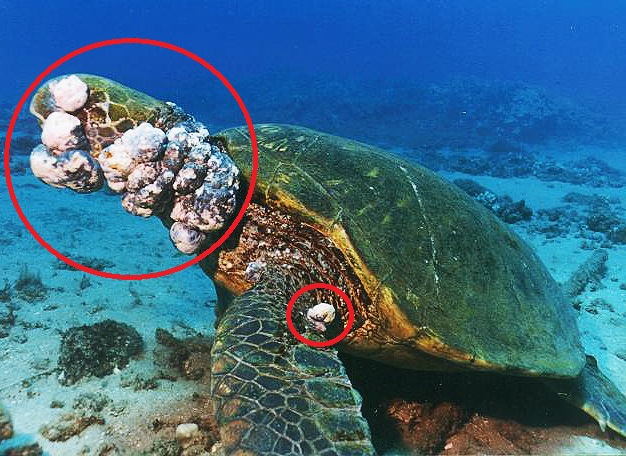
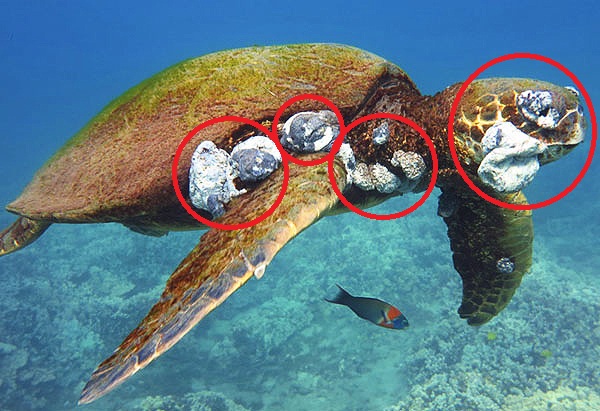
2. Internal Parasites
There are a number of internal parasites found in sea turtles. Some of the most common ones include flatworms and blood flukes. In fact, 33% of loggerhead sea turtles on the east coast are found with disease-producing blood flukes.
Flatworms are also frequently found in sea turtles. All species of flatworms are found in the gastrointestinal tract except for one that has been found in the bladder. Though these flatworms are parasites, they do not necessarily seem to cause weakness to the turtle. Most wild turtles will have some kind of parasite on or within it, but until the population increases to a high number, the parasite may not be debilitating to the animal.
Roundworms are also found in the stomach or intestinal tract of sea turtles, but frequently the turtle will show no indication of a negative impact caused by these parasites.
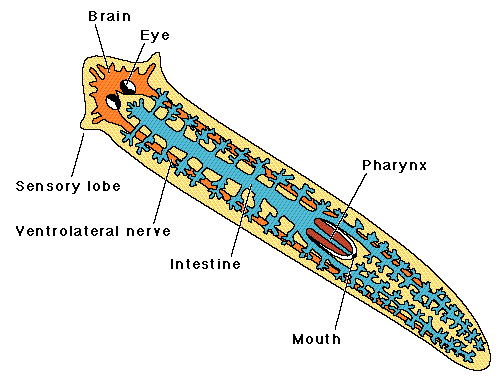
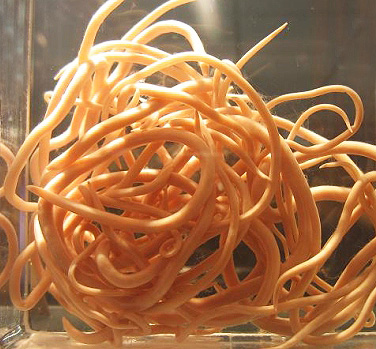
3. External Parasites
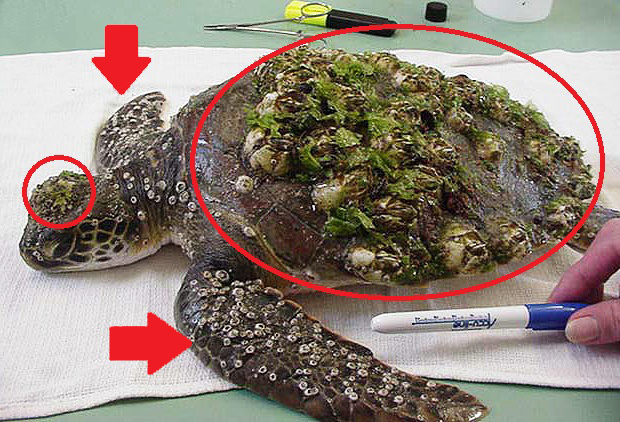 Some of the common external parasites found on sea turtles include leeches and a number of different species that reside on the shell called epibiota. Leeches are usually seen around where the flippers attach to the rest of the body.
Some of the common external parasites found on sea turtles include leeches and a number of different species that reside on the shell called epibiota. Leeches are usually seen around where the flippers attach to the rest of the body.
Epibiota is found on the shell, and these organisms can include barnacles, mollusks, polychaetes, amphipods and algae. Both leeches and epibiota are found most commonly on loggerhead sea turtles. Typically, epibiota doesn’t seem to affect the sea turtle; the organisms and the turtle are in a “commensal” relationship. So, the epibiota benefit from the association and the turtle receives no benefit or detriment from their presence. A healthy turtle can control the amount of organisms by scraping them off with its flippers. Also, as the turtle grows it sheds the scutes (or shell scales) and so some organisms will be evicted that way. However, if a turtle is sick, it may not be strong enough to control the orgasms, and the internal and external parasites will compound. If too many organisms find a home on the turtle shell it reduces the turtle’s speed and drag it down. If the turtle doesn’t scrape them off right away though, they can potentially become permanent residents. Some barnacles are actually only found on sea turtle shells! The treatment in this case is removing these barnacles!
4. Blood Flukes
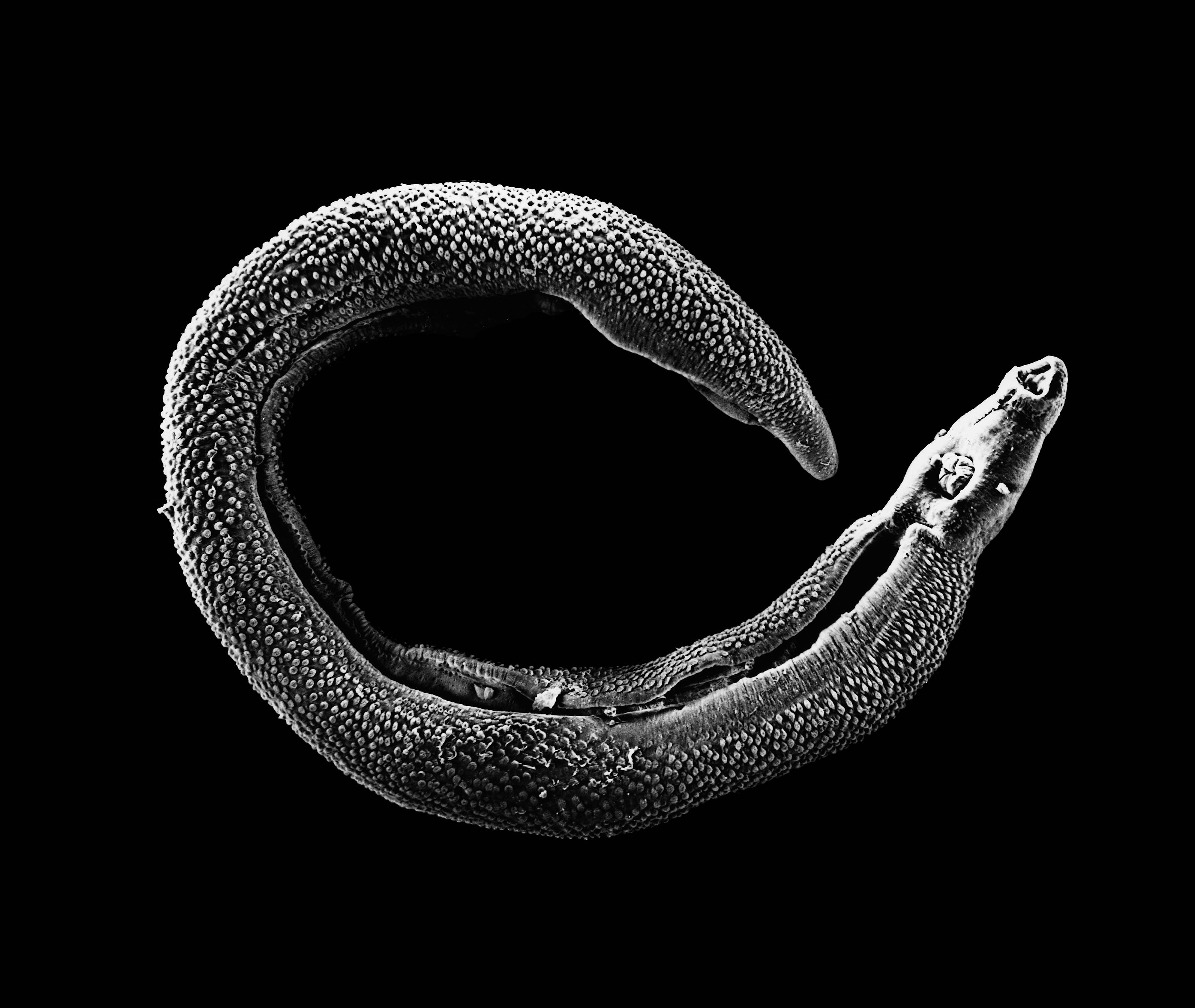 The prevalence of spirorchiid fluke infections of marine turtles is high and may cause the death of the hosts throughout their ranges. Virtually nothing has been reported regarding the infective status of sea turtles stranded on Taiwan. Between 2007 and 2010, 30 Green Turtles (Chelonia mydas) and 2 loggerhead Turtles (Caretta caretta), stranded and dead, were examined for spirorchiid flukes and their eggs. Twenty-four of the green turtles were juveniles, and the stranded loggerhead turtles were subadults. Adult spirorchiid flukes were found in 13 green turtles but not in the loggerheads. Four species of flukes were identified, namely, Leardius learedi, Hapalotrema postorchis, H. mehrai, and Carettacola hawaiiensis. The main infection sites were the major arteries and heart. Seventy percent of the green turtles harbored spirorchiid eggs, but no eggs were found in loggerheads. The largest eggs with bipolar spines, type I eggs, were found in every case. Although more than half of the stranded turtles were infected, parasite infections were not the main cause of death in the green turtles. Fishery by-catch is probably responsible for the mortality of these stranded turtles.
The prevalence of spirorchiid fluke infections of marine turtles is high and may cause the death of the hosts throughout their ranges. Virtually nothing has been reported regarding the infective status of sea turtles stranded on Taiwan. Between 2007 and 2010, 30 Green Turtles (Chelonia mydas) and 2 loggerhead Turtles (Caretta caretta), stranded and dead, were examined for spirorchiid flukes and their eggs. Twenty-four of the green turtles were juveniles, and the stranded loggerhead turtles were subadults. Adult spirorchiid flukes were found in 13 green turtles but not in the loggerheads. Four species of flukes were identified, namely, Leardius learedi, Hapalotrema postorchis, H. mehrai, and Carettacola hawaiiensis. The main infection sites were the major arteries and heart. Seventy percent of the green turtles harbored spirorchiid eggs, but no eggs were found in loggerheads. The largest eggs with bipolar spines, type I eggs, were found in every case. Although more than half of the stranded turtles were infected, parasite infections were not the main cause of death in the green turtles. Fishery by-catch is probably responsible for the mortality of these stranded turtles.
Treatment is with Droncit (Praziquantel).
Read More about Sea Turtles Fibropapillomatosis Virus Disease at:
http://www.cabi.org/isc/datasheet/82638
Read More about Sea Turtles Parasites Disease at:
http://www.seaturtleguardian.org/parasites